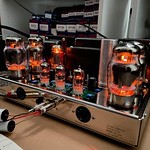 by Peter W. Mon Dec 05, 2016 9:18 am
by Peter W. Mon Dec 05, 2016 9:18 am
Let me see if I can clarify a few behaviors that have served me well over the years.
a) One wants to determine the *BEST* ground available at the intended location.
b) If that becomes the reference ground, it must be one of two things: Either the only ground used, or a ground shared by all equipment.
c) Because: If Unit A uses the reference ground and Unit B uses a different ground not quite as good Unit B will be *above ground* with reference to Unit A.
d) Now the issue of a 'ground loop' comes into play. Sometimes with no consequence, sometimes with significant consequence. Much depends on the nature of the equipment and how far apart the grounds are. To determine the latter, just use your VOM (Ohms) between the reference ground and the 'other' ground. If you get _ANY_ reading at all, you will now see the point of all this.
So, cutting to the chase: I will daisy-chain all my chassis together with an external ground wire to my reference ground. At which point it makes no difference whether the equipment has a 2 or 3 prong plug - if that third ground is chassis connected in the first place - as all the external metal is at the reference ground. Where things get squirrelly is when user-installed grounded plugs come into play. Things may be rendered equally safe without altering the circuit from what either the Engineers designed or UL/CA/CE approved when it was originally made.
One last note: Those of you who still support vinyl. The turntable ground should NOT go to the reference ground but to the headshell of either input jack. Several manufacturers back in the day did this as a matter of course, AR, Rabco and a few others.
As always, each situation is unique. What I have detailed above is the case for the six systems I support, four long-term, two constantly changing at home and at our summer house.





